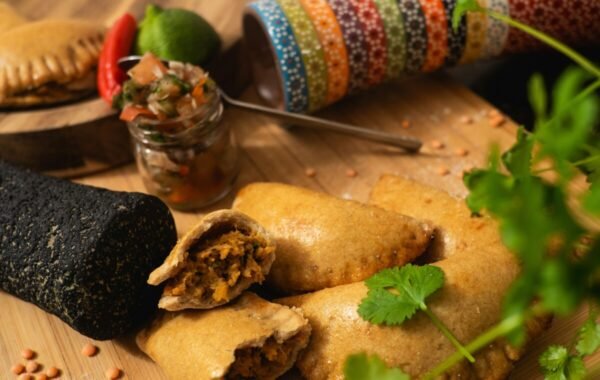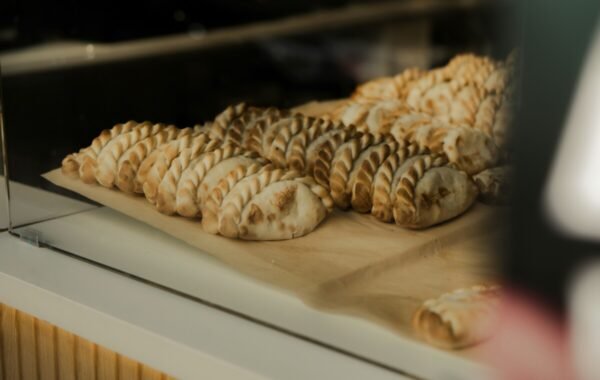
Empanadas in ARGENTINA – Taste the journey
My Quest to Find the Best Empanadas in Argentina and How to Make Them
My quest for the best empanadas in Argentina turned into a food adventure because I found out that I found more than 15 distinct regional styles in one country, a scale that turns a simple snack into a map of migration and agriculture.
I’m going to hook you up with all the insider secrets like noticing those little clues on the counter, the braids, shapes, and how to make them and I’ll even spill the tea on Buenos Aires hotspots like El Hornero and La Morada, giving you a practical travel route and some chill tips on mastering the dough-and-crimping.
My name is Shannon 🙂
I have been travelling full time for the last decade. I have seen and experienced the most wonderful and mysterious things and incredibly excited to share these adventures with you. I thank my lucky stars that i have found myself in a position that I can give you all the tips and tricks needed for a seamless trip. So pack your bags and lets go!
Affiliate Disclosure: Some of the links on our site are affiliate links, meaning, at no additional cost to you, we may earn a commission if you click through and make a purchase. This helps us to continue providing valuable content and supports our efforts in bringing the travel community together. We only recommend products and services we believe in and think you’ll find useful. Complete details are included in our affiliate disclaimer. Thank you for your support!
In a Hurry? Here's our Key Info for This Article
- I tasted regional classics across provinces to build a practical, travel-ready map.
- Shapes and braids act as visual cues to fillings and origin.
- Simple dough and crimping tips make home cooking approachable.
- Buenos Aires venues bring provincial styles to the city for quick sampling.
- Plan pacing so you can try more variety without getting full too fast.
Stay Connected
Things to Do
Essential Apps
Surfshark VPN
Stay safe online and continue accessing all your services just like back home.
Budget Tips
Why This Matters Right Now
Eperiencing empanadas in Argentina showed me how incredible this food can really be. Each province has it’s own way of making them with it’s own history incorporated into how they are traditionally made. These are the reasons I love them.
- Affordable and portable — perfect for sampling.
- Reflects migration and local ingredients by region.
- Easy to share, great for building a weekly menu at home.
From Iberia to Buenos Aires
This simple pastry started way back in Medieval Iberia from a 1520 cookbook, and then landed in our kitchen as a simple food filled with veggies and meat. Traditionally they were meant for farmers and have now become an Argentinian staple.
- Think of it like this: those huge Galician pies shrunk down to the perfect handheld size for folks on the go.
- That 1520 cookbook proves the recipe is ancient. Way before it became an Argentine must-have.
- Local produce is the boss, which is why you get Lamb in Patagonia, awesome knife-cut beef in Cuyo, and even river fish near the Litoral.
- The cool cooking tricks, like using a clay oven and different spice mixes, basically hitched a ride with the people who moved there.
How to Read a Menu like a Map
The ingredients change province by province, showing you all the fillings you can have with this versatile food.
| Origin | Typical Old World Ingredients | New World Adaptations |
|---|---|---|
| Galicia/Portugal | Tuna, chorizo, sardines, tomato, garlic, onion | Sliced pies made portable; added local herbs |
| Colonial routes | Moorish baking techniques, spiced blends | Clay-oven bakes in northwest; regional spice mixes |
| Regional markets | Preserved fish and cured meats | Lamb and venison in Patagonia; knife-cut beef in Cuyo; river fish in the Litoral |
Mastering Authentic Empanada Dough at Home
Making good dough is just easy! Flour, fat an egg, and a splash of water is a reliable base makes the whole recipe really easy and repeatable. If you are a digital nomad in Buenos Aires, this might be a new skill to practice on your travels! Let’s dive in.
Building the Base
To keep it super simple, I just use wheat flour and a little bit of fat for taste and texture, then an egg helps hold it together, and a splash of water blends the mix perfectly without getting sticky, so remember to mix the dry ingredients first and then cut in the fat.
Choosing Lard, Shortening or Oil for Taste and Texture
If you want that rich, old-school flavor, go with lard, but if you want tender dough, shortening is the way to go. If you’re in a hurry, oil works too, so just grab whatever you have in the kitchen.
Rolling, Resting and Cutting Dough Circles
Stick to this easy plan: knead the dough until it’s smooth, roll it out to about the thickness of two dimes stacked up, and then cut out six-inch circles, and don’t skip chilling it for an hour, so the edges seal perfectly and you don’t get any leaks.
- Roll to uniform thickness; re-roll scraps once.
- Keep a light dusting of flour on the board and pin.
- Store dough in the fridge up to 24 hours or freeze for longer prep.


The Essential Fillings Playbook
I always stick to just a few filling recipes that I know and trust, which lets me quickly and consistently check the flavor balance every time.
My favorite filling is a savory mix of ground beef, sweet onions, and bell peppers and then I throw in some olives for some salt, raisins for sweetness and chopped hard-boiled eggs a good texture.
Alternate Proteins and Veg-Friendly Options
Chicken works great with those same spices, just don’t cook it too long so it stays super juicy. I also always find ham and cheese is a winner. Mix mozzarella, provolone, and some cooked onions for that the meltiness, or if you’re going veggie, Humita (creamy corn) is the absolute best. Then add a little garlic and sweet paprika to warm up the flavors without killing the corn.
Spice Cues and Practical Tips
Make sure you season confidently but don’t season too much. Use sweet paprika, tiny bit of cumin, oregano, and black pepper to get that regional flavor and remember to keep the fillings on the drier side so they don’t leak. Always let the mixture cool down before you start filling the dough.
- Test one small fried sample to check salt and spice.
- Think of fillings as modular. Swap protein, keep the spice base.
- Use the table below for quick contrasts before you cook.
| Filling | Key ingredients | Texture & tip |
|---|---|---|
| Beef mixture | Ground beef, onions, bell pepper, olives, raisins, hard-boiled eggs, cumin, sweet paprika, oregano | Rich and chunky; cool before filling to avoid sogginess |
| Fugazzeta-style cheese | Mozzarella, provolone, sautéed onions, oregano, black pepper | Stretchy and savory; use less moisture for good sealing |
| Humita (corn) | Corn, milk or cream, garlic, sweet paprika, a touch of cheese | Creamy and mild; thicken so it holds shape when baked |
How to Assemble, Seal and Cook Empanadas
Make sure you’re using cool filling, measured circles, and keeping the size consistent so they all cook perfectly.
Filling Balance, Sealing and Avoiding Leaks
To make those perfect empanadas in Argentina, just drop a small spoonful of filling in the center, leave a half-inch border, fold it into a neat half-moon, press and firmly crimp the edges (a tiny bit of water helps it stick!). Keep the filling light because too much means leaks and chilling the assembled pieces for about 25 minutes makes a huge difference in stopping them from bursting.
Baking vs. Frying
If you’re frying, get some neutral oil up to around 360F and don’t crowd the pan, planning for about 1–2 minutes per side, but if you’re baking, make sure the oven is hot and brush them with egg wash, then pull them out when they’re golden.
| Method | Heat | Minutes | Finish |
|---|---|---|---|
| Frying | 360°F in vegetable oil | 1–2 minutes per side | Crisp, golden; avoid crowding |
| Baking | High oven heat (preheated) | Until deeply golden (varies by oven) | Brush egg wash; rotate trays halfway |
| Cooling & handling | Room temp on a rack | Let rest 2–3 minutes | Keeps bottoms crisp and prevents sogginess |
Province-by-Province Flavors
Every single region has different fillings, sizes, and how they finish them, so check out my quick guide below on what to expect as you eat your way across the provinces on your travels through Argentina, it’s basically your must-have tasting checklist before you order or start cooking!
Salta and Jujuy
If you’re hunting for the best empanadas in Argentina, you have to go to Salta for the tiny, juicy, clay-oven baked ones stuffed with knife-cut beef, potato, pepper, and chili or check out Jujuy, where the texture has dried beef or llama, peas and olives.
Tucumán
In Tucumán, keep an eye out for those small, party-ready turnovers, usually packed with beef, onions, spring onions, olives, and hard-boiled eggs and you’ll find them fried or baked in a clay oven.
La Rioja and San Juan
The ones in La Rioja are super juicy with rump beef, potatoes, peppers, olives, and sometimes raisins, so definitely grab a napkin, as it’s pretty juicy.
Córdoba
Check out Córdoba, where there is a sweet and savory balance because sometimes the bakers dust the crust with sugar, which is a great match for whatever meat or cheese filling is inside.
Patagonia
When you head down south, you’ll mainly be eating lamb and venison, and if you’re on the coast, there will be seafood empanadas that often have a smoky pepper or merken kick.
Litoral and the northeast
When you’re hanging out in the Litoral area, they often swap out the beef for river fish like dorado, sometimes mixing it up with cheese or white sauce.
Mendoza, Santiago del Estero, Chaco and Buenos Aires
Mendoza and Santiago del Estero often fill theirs with meat and oven bake. Though Santiago often boils their meat first before frying it. Buenos Aires keeps it classic and big with minced beef, onions, greens, bell pepper, egg and olive. Chaco mixes things up with both creole and river-fish fillings, fried or baked depending on who’s cooking and what time of year it is.
Where to Taste the Best in Buenos Aires Right Now
If you only have one afternoon in the city, check out these places, because I picked spots that have the classic frying crunch, awesome vegetarian choices, and that old-school clay-oven magic. If feeling a little lazy, you can also get some empanadas delivered to your door in Buenos Aires, fresh from the places listed below!
El Hornero de San Telmo and La Morada
For folks new to the best empanadas in Argentina, I always send them to El Hornero de San Telmo (Carlos Calvo 455) for their amazing knife-cut beef and Salta-style fillings or try their ham and cheese or humita for something softer and don’t skip La Morada (Larrea 1336) for a reliable, perfectly focused taste of Catamarca right here in the city.
Al Disco and Empanadas Tremendas
There is a place called Al Disco (Alvarez Jonte 3508) where they fry them in pella fat and serve up amazing knife-cut sirloin, bondiola with beer, and humita, but if you want massive variety, check out Empanadas Tremendas (Arcos 3182), which has 17 flavors and even colored doughs. You definitely have to try the flank steak with Malbec there.
Banco Rojo, Buenos Aires Verde, Labor and La Hormiga
Banco Rojo (Bolívar 866) has awesome weekly specials like the shredded lamb and pork rack with bacon, plus a surprising vegetarian bechamel. While Buenos Aires Verde (Vidal 2226) is the perfect spot for super organic, plant-based options. Labor (Gral. Ramón Freire 1501) rules if you love smoked and grilled flavors in your roast tapa and BBQ chicken, and La Hormiga (Armenia 1680) wins with their delicious clay-oven bakes, especially the mushroom or chorizo-provolone-tomato mix that everyone loves.
| Spot | Standout filling | Address |
|---|---|---|
| El Hornero de San Telmo | Knife-cut beef; humita; ham & cheese | Carlos Calvo 455 |
| Al Disco | Knife-cut sirloin; bondiola with beer; fried in pella fat | Alvarez Jonte 3508 |
| Empanadas Tremendas | 17 flavors; flank with malbec; colored doughs | Arcos 3182 |
| Banco Rojo / Buenos Aires Verde / Labor / La Hormiga | Shredded lamb; organic veg; smoked roast tapa; clay-oven chorizo-provolone | Bolívar 866; Vidal 2226; Gral. Ramón Freire 1501; Armenia 1680 |

Plan your Tasting Route
Planning a smart tasting route should always be short, mixed up, and timed just right so you can quickly learn about the timing, portions, and spot the regional clues before you even take a bite.
Sizing and Shape Cues to Spot Regional Styles
Smaller ones usually mean you’ve got those northwest styles like Salta and Tucumán, while the bigger empanadas are usually found in Buenos Aires.
- I suggest planning for just 20–30 minutes per stop, budgeting for two empanadas and some water, and capping your whole food crawl at four places, which takes about an hour and a half.
- Keep your taste buds guessing by mixing up how they’re cooked. Switch between a crispy fried one and a nice clay-oven bake to compare the textures and flavors.
- Split your orders to try more stuff without spending too much; two people can easily smash 6–8 different flavors.
- Schedule a savory empanada run right before a sweet coffee break; those little pauses really help you reset your palate.
- If you’re shooting content, get the outside and inside photos first, and then cut open a hot empanada quickly to catch that awesome steam and filling detail.
| Cue | What it suggests | What to do |
|---|---|---|
| Small size | Northwest regional style | Order two to share |
| Braided rim | Traditional filling or spicy mix | Ask the counter for a quick key |
| Fried vs baked | Texture and oil level | Alternate methods between stops |
Pro Tips for U.S. Home Cooks Celebrating Argentina’s Staple
I’ve got some super simple pantry hacks so you can totally nail those regional flavors without hitting up a bunch of specialty stores, making the whole process super chill for weeknights and small kitchens.
Ingredient Swaps and Quick Rules
- When I’m cooking at home, I just use all-purpose flour and neutral oil if I don’t have lard or shortening; the texture changes a bit but they still come out flaky.
- Keep an eye on the heat with a small thermometer, frying around 360F for 1–2 minutes per side.
- Make sure you chill the dough for about an hour and cut roughly 6-inch circles so they’re easy to seal by hand.
- Always make sure your fillings are cool and not too wet; if the mix looks soupy, just cook it down on the stove for a few extra minutes or drain it a little.
Make-ahead, Freezing and Timing
If you want to save time, you can totally make the dough ahead of time, stack the rounds between parchment and toss them in the fridge, or even freeze the unbaked turnovers and just add a few extra minutes when you bake them, but seriously, always start small, test one batch first, and adjust the salt and spices before you fill the rest.
| Method | Key cue | Practical tip |
|---|---|---|
| Frying | 360°F, 1–2 minutes per side | Use neutral oil and a thermometer for steady heat |
| Baking | Golden crust | Preheat fully; don’t crowd trays |
| Prep | Chill dough 60 minutes | Stack rounds with parchment; cut 6-inch circles |
Argentina Empanadas Guide
Think of my guide to empanadas in Argentina as your secret pocket map where the flavors and look tell the whole story faster than any menu. Just check the size and shape, because those small, juicy ones usually mean Salta-style with potato, while the tiny, party-ready Tucumán versions often have olives and hard-boiled egg hidden inside.
- Córdoba: a sweet-savory twist. Sometimes sugar on the crust.
- Patagonia: lamb or seafood with smoky or peppered notes.
- Litoral: river fish, often paired with cheese or a white sauce.
- Mendoza: knife-cut meat with cumin and garlic warmth.
- Buenos Aires: larger pieces, minced beef with onion and pepper.
The dough is super important for great empanadas in Argentina. Lard makes it flaky while shortening keeps it tender, and both bake or fry up crisp and for fillings, stick to beef and chicken for classics, cheese for comfort, humita for veg, and regional meats for a deeper taste, but seriously, just ask at the counter and the shape and size will tell you everything else so you can order like a pro.
| Region cue | What to expect | Best pick |
|---|---|---|
| Small & braided | Northwest, juicy potato or knife-cut beef | Salta-style |
| Petite, festival | Olives, eggs, bright flavors | Tucumán |
| Large, classic | Minced beef, onion, pepper | Buenos Aires |
Conclusion
Empanadas in Argentina are reflective of local history and farming traditions, with each one’s specific filling and folding technique revealing the unique regional identity
So while traveling, taste them regionally for different experiences. Enjoy eating!
Empanadas in Argentina FAQ
Regional ingredients and techniques shape each version — from mountain lamb and spicy chimichurri in the south to coastal fish and cassava flour in the northeast. Local tastes, available meats, and seasoning traditions create distinct textures and fillings you can spot by size, shape, and aroma.
Keep flour, a fat (lard, butter, or oil), a pinch of salt, cold water, and optionally an egg. These build a flexible dough. I prefer using a mix of butter and a little oil for tenderness and easy rolling, but lard yields the crispest, most traditional crust.
Baking gives a cleaner, lighter result and works well for larger batches. Frying produces a crisper, richer shell and is faster for small portions. Control heat: moderate oven temps (about 375°F/190°C) for 18–25 minutes; medium-high oil for quick browning—watch for golden color to avoid dryness.
Aim for about one tablespoon of filling per 3–4 inch circle for smaller turnovers, and two tablespoons for larger ones. Fill enough to taste meaty but not so much that the edges can’t seal. I always test-seal one before making a full batch.
Absolutely. Swap ground lamb for beef, use green olives if you can’t find Spanish style, and replace lard with butter or vegetable shortening. For humita (corn) fillings, canned corn, fresh cream, and a pinch of sugar work well when fresh corn isn’t available.














